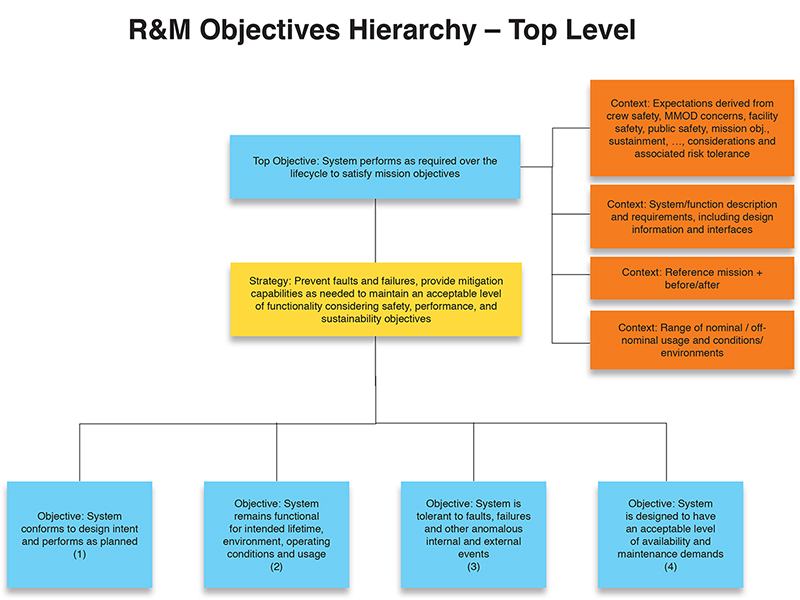NASA’s vision continues to encompass the highest reaches of exploration and technology, with sights set on the frontier of Mars. To better support these increasingly complex missions, the Office of Safety and Mission Assurance (OSMA) is evaluating a new objectives-based approach to standards to ensure that the Safety and Mission Assurance (SMA) disciplines and programs are addressing the challenges of NASA’s changing missions, acquisition and engineering practices, and technology.
Objectives Structure Hierarchies: A New Strategy to Emphasize Intent
The new approach was conceptualized by Safety and Assurance Requirements Division (SARD) Director Dr. Frank Groen and supported by a multi-center team of Reliability and Maintainability (R&M) subject matter experts. The team developed an objectives hierarchy for the R&M discipline to systematically decompose technical considerations that form the basis for the discipline.
The resulting hierarchy is formed by a system of strategies and objectives that build upon each other to support the top objective, which states that “system performs as required over the lifecycle to satisfy mission objectives.” The top objective is flanked by the program or project’s requirements and contexts, which provide the framework for thinking about the objective.
The R&M Hierarchy has four sub-objectives pertaining to the design conformance, longevity, tolerance to faults and failures, and maintainability. The sub-objectives are subsequently deconstructed into increasingly specific objectives and related design and assurance strategies, implicitly capturing the rationale for those lower-level strategies.
The concept utilizes elements of the Goal Structured Notation (GSN). GSN, developed at York University, defines logic-based structures and symbols to document safety or assurance cases. For the R&M hierarchy, a modified version of GSN was used to specify the technical considerations that spaceflight projects are expected to address to support claims about the reliability and maintainability of a system.
The objectives hierarchy does not mandate the use of particular tools or methods. However, strategies at the lower level of the hierarchy are intended to be sufficiently concrete, allowing projects to select appropriate tools and methods suitable for their particular systems and design environments, and — in the R&M hierarchy — to assist reviewers to determine the adequacy of R&M plans and their implementation.
The R&M hierarchy also illustrates that R&M is part of the broad set of engineering and assurance activities, and that many R&M concerns are in fact addressed by other disciplines. Nevertheless, they are considered part of a coherent reliability and maintainability argument, and therefore captured in the R&M hierarchy.
In their paper “A Vision for Spaceflight Reliability: NASA’s Objectives-Based Strategy,” Groen, R&M Manager Dr. John Evans and Risk Analyst Anthony Hall (Information Systems Laboratory) state, “This approach holds the opportunity to enable new directions in an evolving design framework, in which models will govern optimization to achieve the best designs and prescribed documents will take a back seat. The hierarchy itself may look simple, but it is the drivetrain for achieving the reliability necessary for successful missions.”

Top Level of R&M Objectives Hierarchy
According to Evans, “…The hierarchy extracts essentials, without prescriptive process, that may encumber creativity and effective decision-making. It is meant to lead, not follow, and to enable, not to encumber.”
Groen added, “A better understanding of the various technical considerations behind current R&M practices and their interrelationships will enable adaptation and innovation of tools and techniques, and better integration with other disciplines.”
With R&M leading the way, other disciplines have created similar hierarchies including Software Assurance, Expendable Launch Vehicle (ELV) Payload and Range Safety. While no efforts are underway to update standards for these disciplines, the hierarchies provide a consistent way to describe the technical considerations behind existing standards in a consistent manner.
By focusing on objectives, OSMA hopes that the new standards will be more flexible, agile and cost-effective, and will allow more ingenuity to achieve objectives. It will serve as a guide to help programs and projects plan how they will meet their objectives, instead of dictating what they must do to via prescriptive requirements.
The New R&M Standard
The new R&M standard is the first to emerge from the objectives-driven approach.
“We want to move away from the prescriptive effort in Reliability and Maintainability, and have the R&M community focus more on the technical objectives in the process instead of having a ‘check the box’ mentality to completing analyses,” stated Evans.
By focusing on objectives as constructed from the GSN-based objectives hierarchy, the standard allows program managers to determine what is the most efficient course of action and the best documentation to achieve that objective. To ease the transition, the team also has prepared a companion guidebook that will help connect the new standard to more familiar processes. The guidebook will include reference tables that will give some suggested and commonly used options for documents that correspond to a given objective.
“We have to tie the documents to what we are doing, not just go through the motions because we have to,” said NASA Safety Center R&M Technical Discipline Lead Richard Stutts. “When you have a technical objective you have to think about how you’re going to meet that objective. It gets you more engaged in the engineering process.”
The new R&M standard is slated to replace NASA-Standard-8729.1, and, pending incorporation in relevant NPRs, NPD 8720.1.
The new R&M standard is flexible enough to support current strategies, or to support any new system engineering approaches that the agency may adopt in the future.
“Since we are the first ones to emerge with this, I hope it will be seen as a beacon, and that other disciplines will think more about moving this way,” explained Evans.
The new standard is still in development, and has just begun to be informally reviewed by other R&M practitioners. From there it will be revised and then will move to the agency-wide review for NASA standards.